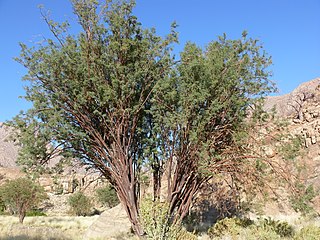
The Mimosoideae are a traditional subfamily of trees, herbs, lianas, and shrubs in the pea family (Fabaceae) that mostly grow in tropical and subtropical climates. They are typically characterized by having radially symmetric flowers, with petals that are twice divided (valvate) in bud and with numerous showy, prominent stamens.
Leslie Pedley was an Australian botanist who specialised in the genus Acacia. He is notable for bringing into use the generic name Racosperma, creating a split in the genus, which required some 900 Australian species to be renamed, because the type species of Acacia, Acacia nilotica, now Vachellia nilotica, had a different lineage from the Australian wattles. However, the International Botanical Congress (IBC), held in Melbourne in 2011, ratified its earlier decision to retain the name Acacia for the Australian species, but to rename the African species.

Senegalia laeta, the gay acacia or daga, is a legume found in the family Fabaceae. It was formerly included in the genus Acacia.

Senegalia berlandieri is a shrub native to the Southwestern United States and northeast Mexico that belongs to the Mimosoid clade of Fabaceae. It grows 1 to 5 metres tall, with blossoms that are spherical and white, occurring from February through April. The berlandieri epithet comes from the name of Jean-Louis Berlandier, a French naturalist who studied wildlife native to Texas and Mexico. S. berlandieri contains a wide variety of alkaloids and has been known to cause toxic reactions in domestic animals such as goats.
Senegalia ankokib is a species of plant in the family Fabaceae. It is found only in Somalia.
Senegalia caraniana is a species of plant in the family Fabaceae. It is found only in Somalia. It is threatened by habitat loss.
Senegalia densispina is a species of plant in the family Fabaceae. It is found only in Somalia. It is threatened by habitat loss.
Senegalia etilis is a species of plant in the family Fabaceae. It is found in Argentina and Bolivia. It is threatened by habitat loss.

Senegalia ferruginea is a species of plant in the family Fabaceae. It is found in India and Sri Lanka.
Senegalia flagellaris is a species of plant in the family Fabaceae. It is found only in Somalia.
Senegalia gaumeri is a species of plant in the family Fabaceae. It is found only in Mexico.
Senegalia manubensis is a species of plant in the family Fabaceae. It is found only in Somalia, and is threatened by habitat loss. Its appearance consists of a small tree with a rounded crown, growing to a maximum of 5 metres tall.
Senegalia moggii is a species of plant in the family Fabaceae. It is found only in Somalia, and is threatened by habitat loss.

Senegalia montis-usti, the Brandberg acacia, is a species of plant in the family Fabaceae. It is found only in Namibia.
Senegalia robynsiana, the whip stick acacia, is a species of plant in the family Fabaceae. It is found only in Namibia.
Senegalia schlechteri is a species of plant in the family Fabaceae. It is found only in Mozambique.

Senegalia is a genus of flowering plants in the family Fabaceae. It belongs to the Mimosoid clade. Until 2005, its species were considered members of Acacia. The genus was considered polyphyletic and required further division, with the genera Parasenegalia and Pseudosenegalia accepted soon after.
Senegalia angustifolia is a species of plant in the family Fabaceae.

Senegalia hereroensis is a species of trees in the genus Senegalia. It is indigenous to Southern Africa, and its native range includes western Zimbabwe, Botswana, and Namibia, and the Northern Provinces, Cape Provinces, and Free State of South Africa. It is native to Zambezian wooded grassland (savanna), and wooded grasslands of the Kalahari-Highveld regional transition zone.

Parasenegalia visco is a perennial tree found at higher elevations in northern Argentina, Bolivia, Chile and Peru. It has also been introduced to Africa. Common names for it include arca, visco, viscote, viscote blanco and viscote negro. It grows 6–25m tall and it has fragrant yellow flowers in the Spring. In Bolivia is found at an altitude of 1500–3000m. It has light to dark reddish brown twigs and small white flowers. It is cultivated for use in cabinetmaking.







